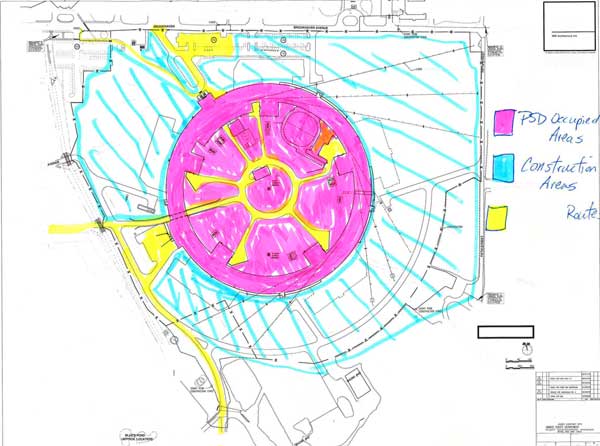NSLS-II Takes Beneficial Occupancy of Ring Building
March 9, 2012
The NSLS-II Project took beneficial occupancy of the ring building on February 29, the last day of the month in this leap year of 2012.
Enabling this important milestone is a procedure little known to most people: beneficial occupancy readiness evaluation, or BORE. Query the Lab’s standards-based management system and you will find a 17-step BORE flow chart detailing what you must do to have limited use of a facility before it’s ready for operations.

NSLS-II ring building. “PSD” stands for Photon Sciences Directorate, which operates the National Synchrotron Light Source (NSLS) and is constructing NSLS-II.
As explained by Marty Fallier, Facilities Division Director for Photon Sciences, “The BORE process assures the safety of occupants and valuable equipment in the facility when we take control of it from the contractor but before it has undergone an operational readiness evaluation.”
Under general contractor Torcon, Inc., construction of the ring building started in June 2009 with the deepest section first, the vehicle and utility tunnel, and then proceeded clockwise from pentant one to pentant five. With the fifth pentant completed, the Lab now has unimpeded access to the entire ring to install equipment and components for the accelerator and experimental stations.
In all, seven BOREs were done for the ring building: one for each of pentants one through four, one for the fifth pentant and lobby, one for the radio-frequency and compressor buildings, and one for the injection building. Brian Heneveld, part of ES&H operations, coordinated all seven BOREs. This separation of the BOREs into discreet sections was deliberate, according to Heneveld, as it allowed occupancy at the earliest possible date. The first BORE, for pentant one and the cooling tower building, was completed on February 1, 2011, and the seventh BORE done a year later, all marching in step with construction progress around the ring.
Lessons learned in the early BOREs were applied later, noted Heneveld, who said that the primary findings were in the areas of fire protection and electrical safety. “In general, though, the lists of BORE findings decreased significantly during subsequent phases,” he added.
Heneveld also described “punch lists” of incomplete or unsatisfactory construction work by the contractor. These lists are made up by construction inspectors and supplemented by the BORE teams. It is the contractor’s responsibility to complete or resolve the list and all requirements of the contract. Some of these items are relevant to the beneficial-occupancy process and are tracked to completion using the Lab’s assessment tracking system, with responsibilities assigned to individuals based on areas of expertise. Other items on the list are contractual requirements and are tracked to completion by Fallier’s construction-management team.
All the temporary walls dividing the five pentants have come down, and the walk around the nearly half-mile ring is an unobstructed circular course – for a brief moment in the project’s timeline. But while this end to the construction phase of the ring building is cause for celebration, it is also cause for increased diligence about safety.
“Having multiple groups of workers in the same space responsible to different supervision is a challenge,” explained Heneveld, referring to a transition period for the NSLS-II Project, as it starts to move beyond conventional construction toward installation of the accelerator and beamlines. He pointed out that work is continuing on the laboratory-office buildings, under general contractor E.W. Howell.
“We are meeting the challenge of transition by proactively and clearly communicating our expectations to supervisors and workers,” said Heneveld.
2012-2944 | INT/EXT | Newsroom









